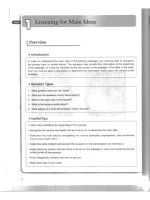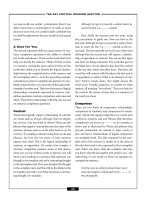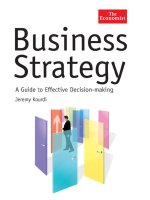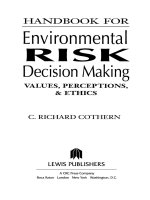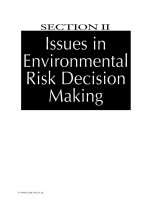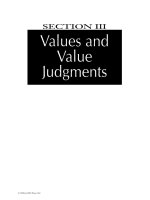HANDBOOK FOR Envi ronmental RESK Decision Making - SECTION 1 ppsx
Bạn đang xem bản rút gọn của tài liệu. Xem và tải ngay bản đầy đủ của tài liệu tại đây (2.89 MB, 50 trang )
HANDBOOK
FOR
Envi
ronmental
RESK
Decision
Making
VALUES,
PERCEPTIONS,
&
ETHICS
C.
RICHARD COTHERN
LEWIS
PUBLISHERS
A
CRC
Press
Company
Boca
Raton London
New
York
Washington,
D.C.
Library
of
Congress Cataloging-in-Publication
Data
Cothern, C. Richard.
Handbook for environmental risk decision making: values,
perceptions, and ethics
/
C. Richard Cothern.
p. cm.
Includes bibliographical references and index.
ISBN 1-56670-131-7 (permanent paper)
1.
Environmental risk assessment Congresses.
2.
Environmental
policy Decision making Congresses. 3. Environmental ethics Congresses.
4.
Values Congresses.
I.
Title.
GE145.C68 1995
363.7'0068'4-dc20 95- 16857
CIP
This book contains information obtained from authentic and highly regarded sources. Reprinted material
is quoted with permission, and sources are indicated. A wide variety of references are listed. Reasonable
efforts have been made to publish reliable data and information, but the authors and the publisher cannot
assume responsibility for the validity of all materials
or
for the consequences of their use.
Neither this book nor any part may be reproduced
or
transmitted in any form
or
by any means, electronic
or
mechanical, including photocopying, microfilming, and recording,
or
by any information storage
or
retrieval system, without prior permission in writing from the publisher.
All rights reserved. Authorization to photocopy items for internal
or
personal use,
or
the personal
or
internal use of specific clients, may be granted by CRC Press LLC, provided that
$SO
per page
photocopied is paid directly to Copyright Clearance Center, 222 Rosewood Drive, Danvers, MA 01923
USA. The
fee
code
for
users
of
the Transactional Reporting Service is ISBN 1-56670-131-
7/96/$0.00+$.50. The fee is subject to change without notice.
For
organizations that have been granted
a photocopy license by the CCC, a separate system of payment has been arranged.
The consent
of
CRC Press LLC does not extend to copying for general distribution, for promotion, for
creating new works,
or
for resale. Specific permission must be obtained in writing from CRC Press LLC
for such copying.
Direct all inquiries to CRC Press LLC,
2000
N.W. Corporate Blvd., Boca Raton, Florida 33431.
Trademark
Notice: Product
or
corporate names may be trademarks
or
registered trademarks, and are
used only for identification and explanation, without intent to infringe.
Visit the CRC
Press
Web site at
0
1996 by CRC Press LLC
Lewis Publishers is
an
imprint of CRC Press LLC
No claim to original
U.S.
Government works
International Standard Book Number 1-56670-131-7
Library of Congress Card Number 95-16857
Printed in the United States of America 2 3
4
5
6 7
8
9
0
Printed on acid-free paper
www.crcpress.com
PREFACE
A one-day symposium on “Environmental Risk Decision Making: Values,
Perceptions and Ethics” was held by the Environmental Division at the National
Meeting of the American Chemical Society in Washington, D.C., August 24,
1994. The symposium consisted of 2 keynote speakers and 14 following
presentations. The papers presented are combined with eight others to flesh out
the topics for this volume.
WHAT DO VALUES AND ETHICS HAVE TO DO
WITH ENVIRONMENTAL RISK DECISION MAKING?
Values and ethics should be included in the environmental decision-
making process for three reasons: they are already a major component, al-
though unacknowledged; ignoring them causes almost insurmountable diffi-
culties in risk communication; and because it is the right thing to do.
Values and value judgments pervade the process of risk assessment, risk
management, and risk communication as major factors in environmental risk
decision making. Almost every step in any assessment involves values and
value judgments. However, it is seldom acknowledged that they even play a
role. The very selection of methodology for decision making involves a value
judgment. The selection of which contaminants to study and analyze involve
value judgments. Weighing different risks involves value judgments. We
cannot, and should not, exclude values and value judgments from the environ-
mental decision-making process as they are fundamental to understanding the
political nature of regulation and decisions that involve environmental health
for humans and all living things.
One of the major problems in risk communication is the failure of different
groups to listen to each other. For example, many animal rights groups object
to the use of animals in toxicological testing on ethical and moral grounds. The
AMA and other scientific groups have mounted a response that argues that
many human lives have been saved (life lengthened) by information gained
from animal testing. Both sides have a point, but neither is listening to the
other. These represent two different value judgments and these values are
the
driving force in the different groups. It is essential to understand this and
include it in any analysis that hopes to contribute to understanding in this area.
Any analysis must include values such as safety, equity, fairness, and justice
-
as well as feelings such as fear, anger, and helplessness. These values and
feelings are often the major factor in effectively communicating about an
environmental problem.
© 1996 by CRC Press LLC
Lastly, including values such as justice, fairness, and equity (present and
intergenerational) is the right thing to do. Any effective environmental pro-
gram
needs to be ethical to survive in the long term.
ENVIRONMENTAL
RISK
DECISION MODELS
The existing models for environmental risk assessment do not contain any
explicit mention of values, value judgments, ethics, or perceptions. However,
these are often the main bases used in making such decisions.
For example:
Alar was banned to protect
children.
The linear, no-threshold dose response curve and the use of combined upper
95%
confidence limits are based on
safety
not science.
The Superfund program started
with
the
idea
that
if
I
can sense it,
it
must
be bad, while indoor radon has met
with
widespread apathy because
it
cannot be sensed,
so
why
worry?
The idea of zero discharge is based on the
sanctify ofthe individual.
Forests and wetlands are preserved because of
stewardship.
Nuclear power
is
avoided because of
fear
of
catastrophe.
The general theme of the symposium was to examine the place of values,
value judgments, ethics, and perceptions in decision models. The hypothesis is
that these characteristics are directly involved in current risk decisions, but that
existing models do not include them. In some decisions, attempts are made to
disguise these characteristics of values and ethics with other labels such as
“scientific” or “technical”. Values and ethics seem like perfectly good ways to
analyze, balance, and choose in the environmental risk decision-making pro-
cess and since they are widely used, why not acknowledge this and formally
include them in the models?
Are the current and future environmental problems and decisions more
complex and of a different character that those of the past? If
so,
then a new
decision paradigm will be needed. Some have observed that the current envi-
ronmental problems are characterized by levels of complexity and uncertainty
never before experienced by any society.
GOAL AND OBJECTIVES OF THE SYMPOSIUM
The goal of
this
volume is to examine the place values and value judg-
ments have in the process of environmental risk decision making.
Broadly stated, there are three major objectives: viz., bring together the
disparate groups that are and have been working in this area; develop a model
of environmental risk decision making that includes values, perceptions, and
ethics; and develop an environmental ethic.
© 1996 by CRC Press LLC
To
bring together disparate groups to share thoughts and biases concerning
the role
of
values in environmental risk decision making
-
a partial list is
shown below:
Ethicists
Decision makers
Risk assessors
Economists
Scientists
Philosophers
Journalists
Theologians
Attorneys
Policy makers
Environmentalists
Regulators
To
develop a model that describes how the participants think environmental
risk decision making should be conducted. This process involves several
components:
1.
To
explore the involvement
of
values and value judgments in the devel-
opment
of
risk assessments, cost assessments, and feasibility studies
2.
To
examine current environmental decisions to determine the role values
and value judgments play in the process
3.
To
develop approaches and methodologies that can involve the so-called
objective and subjective elements into
a
balanced process
for
making
environmental risk decisions
4.
Looking
for
what the options are, determine how to balance all the
components
of
decision making and to be explicit about the values,
perceptions and ethics
To
promote the development
of
an environmental ethic
One overall objective is to use the value of honesty and
ask
that the values,
value judgments, and ethical considerations used in environmental risk decisions
be expressed and discussed. To a scientist, Brownowski’s comment, “Truth in
science is like Everest, an ordering
of
the facts”, is a most important value.
It
is a conclusion
of
this line
of
thinking
that
we should
unmask
the
use
of
values in environmental decisions and challenge decision makers to clearly
state
how
they are
using
values.
SUMMARY
The summary presentation
of
the symposium consisted of three proposi-
tions and
four
recommendations. The strong versions
of
the propositions are
© 1996 by CRC Press LLC
representative of the views of many of the participants, while the weaker
versions would be shared by only some of the participants.
The first proposition in strong form is that all facets of risk assessment are
value laden. A weaker version of this is that risk assessment is socially
constructed and thus depends on the context.
The strong version of the second proposition is that public values are
relevant in standard setting. A weaker version of this proposition is that public
values should trump scientific value when there is a conflict.
For the third proposition, the strong version is that risk assessment is an
appropriate aid in spite of the deficiencies, while the weaker version is that we
should make more use of it.
The four recommendations that emerged are
1.
More attention needs to be
given
to
the
definition
of
values
and
ethics
in
risk
assessment.
2.
Given the overconfidence
that
we have
in
risk assessment, we need more
humility.
3.
Mistrust
is
one
of
the
more
serious problems
that
needs to be addressed.
4.
Stop bashing the
media
and
lawyers -there
is
enough
blame
to
go around.
C. Richard Cothern
Chevy Chase, Maryland
COMMENTS
FROM
MY
CO-ORGANIZER,
PAUL
A.
REBERS
These last paragraphs in the preface are comments from the other orga-
nizer
of
the symposium on which this volume is based. Paul
A.
Rebers was not
only a co-organizer
of
the symposium, he was the original source
of
the idea.
My contribution to this book is dedicated to my parents, who taught me
ethics; and to Dr. Fred Smith and Dr. Michael Heidelberger who taught me the
value of, and the necessity of, an ethical code in order to do good research.
There can be no substitute for good mentors in and after college. After
I
had
earned my Ph.D., Dr. Heidelberger taught me to do the “Heidelberger Control”,
i.e., in order to be more certain of the results, to do one more control, and to
repeat the experiment. Dr. Richard Cothern helped me realize the need for
looking at the broad picture in making environmental risk assessments.
This symposium was concerned with how values, ethics, and perceptions
impact on the making of environmental risk assessments. Ethics were touched
on in a previous symposium presented at the ACS national meeting in Boston
in
1990
entitled, “Ethical Dilemmas of Chemists”, which
I
organized, and was
a
basis for the present symposium and book.
© 1996 by CRC Press LLC
© 1996 by CRC Press LLC
If we can recognize that values, ethics, and perceptions, as well as scien-
tific data enter into the process of environmental
risk
decision making, we will
have made an important step forward. This should make it easier for the public
to
understand how difficult and indeterminate the process may be.
It
should
also make them demand to know the biases as well as the expertise of those
making decisions. By being completely honest with the media and the public,
we are making an important step in gaining their confidence, and I hope this
can be done more in the future than it has been done in the past.
The
Editor
C.
Richard Cothern, Ph.D.,
is presently with
the
U.S.
Environmental Protection Agency’s
Center for Environmental Statistics Development
Staff. He has served as the Executive Secretary
of the Science Advisory Board at the U.S. EPA
and as their National Expert on Radioactivity
and Risk Assessment in the Office of Drinking
Water. In addition, he is a Professor of Manage-
ment and Technology at the University of
Maryland’s University College and an Associate
Professorial Lecturer in the Chemistry Depart-
ment of the George Washington University. Dr.
Cothern has authored over
80
scientific articles including many related to
public health, the environment, and risk assessment. He has written and edited
14
books, including such diverse topics as science and society, energy and the
environment, trace substances in environmental health, lead bioavailability,
environmental arsenic, environmental statistics and forecasting, risk assess-
ment, and radon and radionuclides in drinking water. He received his B.A.
from Miami University (Ohio), his M.S. from Yale University, and his Ph.D.
from the University
of
Manitoba.
© 1996 by CRC Press LLC
Contributors
Richard
N.L.
Andrews
Department
of
Environmental
Sciences and Engineering
University
of
North
Carolina
Chapel Hill, North Carolina
Jeffrey Arnold
Department
of
Environmental
Sciences and Engineering
University
of
North
Carolina
Chapel Hill,
North
Carolina
Scott
R.
Baker
Director, Health Sciences Group
EA Engineering, Science and
Silver Spring, Maryland
Technology, Inc.
Lawrence
G.
Boyer
Department
of
Public
Administration
The George Washington University
Washington,
D.C.
Donald
A.
Brown
Director
Department
of
Environmental
Bureau
of
Hazardous Sites
Commonwealth
of
Pennsylvania
Harrisburg,
Pennsylvania
Resources
Thomas A.
Burke
School
of
Hygiene and Public
Johns Hopkins University
Baltimore, Maryland
Health
Bayard
L.
Catron
Department
of
Public
Administration
The
George
Washington University
Washington,
D.C.
Victor
Cohn
American Statistical Association
Washington,
D.C.
William
Cooper
Biology Department
Michigan State University
East
Lansing, Michigan
C.
Richard
Cothern
Center
for
Environmental Statistics
Development Staff
Environmental Statistics and
U.S.
Environmental Protection
Washington,
D.C.
Information Division
Agency
Douglas
J.
Crawford-Brown
Institute for Environmental Studies
Department
of
Environmental
Sciences and Engineering
University
of
North
Carolina
Chapel
Hill,
North
Carolina
William
R.
Freudenburg
Department
of
Rural
Sociology
University
of
Wisconsin
Madison, Wisconsin
Jennifer
Grund
PRC
Environmental
Management,
Inc.
McLean, Virginia
Contributors
Richard N.L. Andrews
Department of Environmental
Sciences and Engineering
University of North Carolina
Chapel Hill, North Carolina
Jeffrey Arnold
Department
of
Environmental
Sciences and Engineering
University of North Carolina
Chapel Hill, North Carolina
Scott R. Baker
Director, Health Sciences Group
EA Engineering, Science and
Silver Spring, Maryland
Technology, Inc.
Lawrence
G.
Boyer
Department of Public
Administration
The George Washington University
Washington, D.C.
Donald
A.
Brown
Director
Department of Environmental
Bureau of Hazardous Sites
Commonwealth of Pennsylvania
Harrisburg, Pennsylvania
Resources
Thomas
A.
Burke
School of Hygiene and Public
Johns Hopkins University
Baltimore, Maryland
Health
Bayard L. Catron
Department
of
Public
Administration
The George Washington University
Washington, D.C.
Victor Cohn
American Statistical Association
Washington, D.C.
William Cooper
Biology Department
Michigan State University
East Lansing, Michigan
C. Richard Cothern
Center for Environmental Statistics
Development Staff
Environmental Statistics and
U.S. Environmental Protection
Washington, D.C.
Douglas J. Crawford-Brown
Institute for Environmental Studies
Department of Environmental
Sciences and Engineering
University of
North
Carolina
Chapel Hill,
North
Carolina
William
R.
Freudenburg
Department of Rural Sociology
University of Wisconsin
Madison, Wisconsin
Information Division
Agency
Jennifer Grund
PRC Environmental
Management, Inc.
McLean, Virginia
© 1996 by CRC Press LLC
Rachelle D. Hollander
National Science Foundation
Ethics and Values Studies Program
Arlington, Virginia
P. J. (Bert) Hakkinen
Senior Scientist, Toxicology and
Risk Assessment
Paper Product Development and
Paper Technology Divisions
The Procter
&
Gamble Company
Cincinnati, Ohio
John Hartung
Office of Policy Development
U.S. Department of Housing and
Washington, D.C.
Urban Development
Carolyn
J.
Leep
Chemical Manufacturers
Washington, D.C.
Association
Douglas MacLean
Department
of
Philosophy
University
of
Maryland
Baltimore, Maryland
Hon. Mike McCormack
The Institute for Science and
Ellensburg, Washington
Society
James
A.
Nash
The Churches’ Center for Theology
Washington, D.C.
and Public Policy
Bryan
G.
Norton
School of Public Policy
Georgia Institute of Technology
Atlanta, Georgia
Christopher J. Paterson
Northeast Center
of
Comparative
Vermont Law School
South
Royalton, Vermont
Risk
Van
R.
Potter
Department of Oncology
University of Wisconsin
Madison, Wisconsin
Resha M. Putzrath
Georgetown
Risk
Group
Washington, D.C.
David
W.
Schnare
Office of Enforcement and
Compliance Assurance
US. Environmental Protection
Agency
Washington, D.C.
Virginia
A.
Sharpe
Departments of Medicine and
Georgetown University
Washington, D.C.
Philosophy
Kristin Shrader-Frechette
Environmental Sciences
and Policy Program and
Department of Philosophy
University of
South
Florida
Tampa, Florida
© 1996 by CRC Press LLC
© 1996 by CRC Press LLC
Table
of
Contents
Section
I:
INTRODUCTION
1.
Values and Value Judgments
in Ecological Health Assessments
William Cooper
2.
Strange Chemistry: Environmental Risk Conflicts
in a World
of
Science, Values, and Blind Spots
William
R.
Freudenburg
Section
II:
ISSUES IN ENVIRONMENTAL
RISK
DECISION
MAKING
3.
An Overview
of
Environmental Risk
Decision Making: Values, Perceptions, and Ethics
C.
Richard Cothern
4.
Introduction to Issues in
Environmental Risk Decision Making
Scott
R.
Baker
5.
Industry’s Use
of
Risk, Values,
Perceptions, and Ethics in Decision Making
P. J. (Bert) Hakkinen and Carolyn J. Leep
6.
Regulating and Managing Risk:
Impact
of
Subjectivity on Objectivity
Scott
R.
Baker
7.
Back to the Future: Rediscovering the Role
of
Public Health in Environmental Decision Making
Thomas
A.
Burke
8.
Telling the Public the Facts
-
or
the Probable Facts
-
About
Risks
Victor Cohn
© 1996 by CRC Press LLC
9.
The Urgent Need to Integrate Ethical
Considerations into Risk Assessment Procedures
Donald A. Brown
10.
The Problem
of
Intergenerational Equity: Balancing
Risks, Costs, and Benefits Fairly Across Generations
Bayard L. Catron, Lawrence
G.
Boyer, Jennifer Grund,
and John Hartung
SectionIII
:
VALUES AND VALUE JUDGMENTS
11.
Introduction
to
Quantitative Issues
David
W.
Schnare
12.
Ecological
Risk
Assessment:
Toward a Broader Analytic Framework
Bryan
G.
Norton
13.
Environmental Ethics and Human Values
Douglas MacLean
14.
Moral Values in Risk Decisions
James
A.
Nash
15.
Values and Comparative Risk Assessment
Christopher J. Paterson and Richard N.L. Andrews
16.
Risk and Rationality in Decision Making:
Exposing the Underlying Values Used
When Confronted by Analytical Uncertainties
David
W.
Schnare
17.
Comparing Apples and Oranges:
Combining Data on Value Judgments
Resha
M.
Putzrath
18.
The Ethical Basis
of
Environmental
Risk
Analysis
Douglas J. Crawford
-
Brown
19.
Ethical Theory and the Demands
of
Sustainability
Virginia A. Sharpe
20.
The Cardinal Virtues
of
Risk Analysis: Science
at the Intersection
of
Ethics, Rationality, and Culture
Douglas J. Crawford
-
Brown and Jeffrey Arnold
© 1996 by CRC Press LLC
© 1996 by CRC Press LLC
21.
Value Judgments Involved in Verifying
and Validating Risk Assessment Models
Kristin Shrader
-
Frechette
22.
The Stewardship Ethic
-
Resolving the Environmental Dilemma
David
W.
Schnare
Section IV: COMMENTARY
23.
Introduction to the Commentary Section
C. Richard Cothem
24.
Awakenings to Risk in the Federal
Research and Development Establishment
Rachelle D. Hollander
25.
The Citizenship Responsibilities of Chemists
Hon. Mike McCormack
26.
Global Bioethics: Origin and Development
Van
R.
Potter
Section
V:
SUMMARY
27.
Ethics and Values in Environmental
Risk Assessment
-
A
Synthesis
Bayard
L.
Catron
The Contributors
Dedication
To
Ellen Grace, Hannah Elizabeth, and all future generations we pass on
the
torch of attention
to
the impact of values, perceptions, and ethics in life’s
decision making.
© 1996 by CRC Press LLC
SECTION
I
© 1996 by CRC Press LLC
© 1996 by CRC Press LLC
VALUES AND VALUE JUDGMENTS IN
1
ECOLOGICAL HEALTH ASSESSMENTS
William
Cooper
CONTENTS
Introduction
Values in Ecological Risk Assessments
Values in Other Risk Assessments
Value Trade
-
Offs
Conclusion
References
INTRODUCTION
It is unusual to
start
a symposium and this volume
1
on
the subject of values
and ethics with the views of an ecologist. Doing
so
is a conscious value
judgment. The importance of values and ethics is seldom discussed during
ecological debates.
This
discussion is an empirical observation about the way
judgments are made and
on
how data are weighted when we make decisions
involving ecological health.
My background involves, among other things, serving for
14
years
on
a
state environmental review board that ran public hearings for federal and state
governments concerning environmental impact statements.
You
really get an
education in a meeting with
200
people who are madder than hell. I also chaired
the Ecology and Welfare panel
on
the Reducing Risk project
2
for William
Riley, the Administrator of the
U.S.
Environmental Protection Agency. The
panel had to rank ecological and welfare effects (dollars and "dickey
bird"
3
)
to show where the priorities are and where one can get the biggest bang for the
buck in environmental problem setting.
In these experiences, I had to deal with values. Any time you confront
issues like risk assessment, land use, and wetlands, everyone has their own
perceptions as to what is important or unimportant. They bring different
backgrounds, experiences and biases to this pragmatic and empirical surround-
ing and provide a realistic forum to examine the importance of values.
VALUES IN ECOLOGICAL
RISK
ASSESSMENTS
Ecologists think differently from everyone else. We have our own mind
set of how one makes optimal trade-offs of ecological criteria based largely on
evolution. The only criterion for good or bad is whether the gene pools survive
to have more offspring. Everything else as a value is secondary. A quick
empirical example of how natural selection determines “ecological correct-
ness’’ is the following. A couple
of
years ago there were some whales caught
in the ice off Alaska and every night on TV for about
6
nights there were stories
of the whales and the millions of dollars being spent trying to free them. This
approach set marine biology back about
100
years in its lack of common sense.
About halfway through that week,
I
got a phone call from our local newspaper
reporter requesting a quote.
I
replied, “Any whales caught up in the ice are
so
dumb that you don’t want them to have kids. That is how population models
work.
You
do not support the continuation of that kind of maladapted behavior
and the best thing to do is to stop that line.”
There is a value judgment in comparing ecological and human health
-
which is more important? This relationship is not competitive, it is complimen-
tary. In real life you do not have a choice -if you want to maintain a high level
of human health you must invest in the environment. For example, look at
Eastern Europe. It is a false argument to play ecological health and human
health against each other. The first thing you must deal with in addressing
environmental issues is social perception
-
the values involved. Often folks
do
not want to hear what the scientist has to say. Too many have a romantic
idea of how nature should work
-
they envision Bambi, Flipper, Smokey the
Bear, and a warm and fuzzy Walt Disney love-in. In nature just the opposite
is the case. Ecological systems
are
very harsh, abrupt, and chaotic. There are
high mortality rates. This is a completely different perception than that in the
average public mind. Take the case of Smokey the Bear, a value in the Forest
Service for three generations. Any school kid will tell you that Smokey is a
good guy. However, with the forest fires in the West this season you need to
re-educate a whole population that to keep the forest landscape safe includes
natural events like fires. Fire is a natural and central need in landscape man-
agement. There is a difference in perceptions.
I
am not sure I can translate these
values and perceptions into quantitative parameters, but I understand the
distinction.
© 1996 by CRC Press LLC
Table
1
Ecological Rankings
High
Habitat alteration/destruction
Species extinction
Stratospheric ozone depletion
Global climate change
Medium
Herbicides and pesticides
Toxics, nutrients, BOD in water
Acid deposition
Airborne toxics
Low
Oil spills
Groundwater pollution
Radionuclides
Acid runoff
Thermal pollution
From Reducing Risk: Setting Priorities and
Strategies
for
Environmental Protection,
US.
EPA, Science Advisory Board, SAB-
EC-90-021, September, 1990.
Perceptions become critical when we try to combine social values, land
use, economic issues, property rights, expectations, and all the human values
to determine trade-offs between ecological balance and social opportunity. It
is easier for the ecologist to rationally balance ecological rankings among the
four most important problem areas in ecology: global warming, stratospheric
ozone, biological diversity, and loss of habitat (see
).
The panel on
ecology and welfare for the Reducing Risk project concluded that these were
more important than groundwater and Superfund problems. This conclusion is
a value judgment itself.
The human health panel was asked to rank contaminants, carcinogens, and
noncarcinogens, but finally this group of eminent scientists decided that they
could not agree concerning the relative rankings. It is the ethical structure of
medicine that does not allow them to say what is more important to society
-
how to compare a 75-year-old dying of cancer or an urban chdd of 6 months who
is mentally retarded because of ingested or inhaled lead. There was no way they
could find to rank these
-
and
so
they did not. We ranked our ecology problems
with no ethical problems whatsoever. In estimating the value of an eagle
I
did not
have to worry whether it was happy or someone had violated its individual rights.
In population assessments, the fate of an individual is irrelevant.
You
might have
noted recently in the
New
York
Times
the article in the science section on
hormonal copycats
-
the estrogenic compounds. Incidences of alligators with
small penises, men with low sperm counts, and diseases in populations
of
© 1996 by CRC Press LLC
Table 1
Is0
-
OCCUPIED
NESTS
-smMucrrm
/
Figure
1
Michigan bald eagle production summary, 1973-1 993.
wildlife in the Great Lakes were attributed to exposures to toxic substances. The
compounds involved are
PCBs,
dioxins, furans, chlorinated pesticides, and a few
others. If you actually
look
at the data of eagle populations in the Great Lakes
it shows that the populations have been growing exponentially since the
1970s
(see
).
There is no indication of ecological impact whatsoever at the level
of the population. It is absolutely true that you can
go
out and find hot spots such
as Saginaw Bay and some areas in Wisconsin where there are very large amounts
of chlorine-containing compounds in the sediments, and you can find eagle
populations where there are deformed chicks
-
one or
two
here and there.
Thus,
there is evidence that individual eagles are impacted. Again, one does not have
to protect andor value individual survivorship in order to protect and preserve
the ecological resource.
© 1996 by CRC Press LLC
Figure 1
VALUES
IN
OTHER
RISK
ASSESSMENTS
There is a big debate going on right now proposing the virtual elimination
of all chlorine-containing compounds. The idea is to eliminate most chlorine-
containing compounds in feedstock and products in all the Great Lakes states
and the entire
U.S.
This proposal is based on the idea that these compounds are
affecting eagles, Beluga whales,
mink,
and everything else that has decreased
in population in the last
20
years.
It
is guilt by temporal association with these
chlorine-containing compounds. Can you imagine banning an element in the
periodic table based on that kind of data? This is a value judgment and involves
trade-offs. Even if there has been such an impact,
so
what? Do you know what
the impact would be of banning the majority of the chlorine-containing com-
pounds
in
pharmaceuticals, insecticides, and the chlorination of water? Even if
you can show effects, one of the problems is, at what level?
Is
this not an
extreme example of overemphasizing pristine ecological conditions? Any
analysis of chlorine compounds and their ecological health effects involves risk
assessment. When we first got into the area of ecological risk assessment, the
thought was to take the National Academy of Sciences’s “red book”4 and paint
it green. For example, generate dose-response curves for eagles and other
wildlife animals for expected individual exposures. That is exactly what the
Fish and Wildlife Service
is
doing. Many conservation groups argue that the
goal of risk assessment is to get the level of permissible concentrations as low
as you can get them, as close to zero as possible, no matter what the costs are.
If you are a conservationist and your major value in life is to protect “dickey
birds” you might take the same approach. However, from a scientific view this
is wrong. It is wrong because you cannot protect an individual in the wildlife
population. The human health risk assessment model puts a value on an
individual life; but in nature, the individual is expendable. The only thing of
value in an ecological population model is the perpetuation of the gene pool.
The major mechanism is called natural selection. The Endangered Species Act
does not protect individuals -it protects habitat. If you protect the habitat, the
populations will take care of themselves. You cannot legislate that
an
indi-
vidual baby eagle must survive. You can argue that the Endangered Species
Act protects the individual and use this as an excuse to crank down the ambient
concentrations as low as you can get them, but ecological science does not
justify that kind of draconian measure. This argument represents the value
judgment of whether or not one makes the decision based only on science.
Back when life was simple, and chemists weighed things in milligrams,
everything was black and white, dirty
or
clean. We passed the Delaney amend-
ment stating that if a contaminant is a known or suspect carcinogen there
cannot be one molecule of it in a food additive. That was fine when we were
measuring things in milligrams, because a value below the detection limit was
assumed to be zero. The problem is that we spent all kinds of money to push
detection limits orders of magnitude lower, and in the case of 2,3,7,8-dioxin
(dichloro-p-dibenzodioxin)
the detection level is down to ten
to
the minus
© 1996 by CRC Press LLC
sixteenth
(10-l6).
Now, what does below detection limit mean? The question
is one of values and what is an acceptable risk has become more complicated.
The normal kind of command-and-control EPA regulations involve setting a
number for the discharge to the air or water or whatever
so
that there is a certain
level of protection. This level is of the order of in a lifetime of
exposure. As an example, PCBs have an action level of
2
parts per million in
fish (if you eat
6.5
grams per day,
365
days per year for
72
years, the
probability of dying from exposure to this compound at this concentration is
about 1 in
100,000).
You
can look at that number as a level of protection that
EPA and FDA have guaranteed the public. Or you can view this number as a
license to kill
-
the permitting of a discharge knowing that it will be accumu-
lated in the fish population and that people will die at the level
of
1
in
100,000.
Is the cup half empty or half full? This level is considered a safe number and
it can be interpreted either way. The choice is
a
value judgment.
The idea that we are safe when exposed to levels below a standard is one
option. Another is to mandate zero discharge
or
nondetectable discharge, no
matter what the cost is. If you accept this as a level of protection, then when
do you stop spending money on the mitigation and spend it on alternate social
problems like schools, housing, and the poor?
You
are out in the real world and
if you value human life, then perhaps it is better to focus on problems like
alcohol, tobacco, diet, and automobiles. Here the mortality rates are in the
range
of
lo-*
and where the environmental regulation is in the range
of and Where do your values and priorities lie?
Involved here are trade-offs in comparative risk assessment and balancing
values. Some difficulties include different endpoints and different conclusions
on the same set of data, all depending on our values. What you will find out
when you do risk assessment for human health is that it is halfway between
black magic and a Ouija board, and for ecological risk the problem is much
worse. It basically comes down to common sense and best professional judgment.
For many of the multitude of environmental issues you cannot put prob-
abilities on the events. I cannot draw a dose-response curve for global warm-
ing, stratospheric ozone, loss
of
habitat, or species
loss,
all the kind of things
that ecologists worry about. These major issues are not probabilistic or inten-
sity dose-response curves. They are scenarios or events; they are occurrences.
Almost all of these kinds
of scenarios begin with a little bit of data, a few
simulation models, maybe some regression lines, extrapolations in time and
space for anything you can measure, and then you have to fill in the gaps with
good old professional best judgment.
Sometimes lawyers and juries have problems with too much professional
judgment and not enough hard data. They say that there is too much uncertainty
and they cannot make a decision. However, decisions will be made whether
you like it or not. Either scientists belly up to the bar and contribute their own
professional judgment, or others will make the decisions without the con-
straints of thermodynamics, evolution, or calculus. The fallback position is that
to
© 1996 by CRC Press LLC
economists and lawyers will make the decisions, and they are not constrained
by the laws of science.
You cannot print money fast enough to solve all the environmental prob-
lems to the level of zero risk simultaneously. The bottom line is that our society
is like a bunch of spoiled brats who want an affluent lifestyle based on a throw-
away society, supplied by synthetic chemistry and risk free at the same time.
How are you going to do that?
VALUE
TRADE-OFFS
Having a certain level of risk, a nonzero risk, involves cost. That is the
kind of balancing act that we are involved in right now, and if you expect either
extreme you will have trouble. A couple of quick scenario examples of what
I
mean by trade-offs follow.
Remember back in the late
1950s
Lake Erie was supposed to be dying? We
look back with hindsight, and realize that our freshwater lakes in the
U.S.
are
usually phosphate limited. In a phosphate-limited lake, green algae dominate,
not blue-green algae. The zooplankton will eat the green algae and, therefore,
Lake Erie had a grazing food chain in the
1930s
and
1940s.
Lake Erie had one
of the highest social values of any lake in North America. It was one of the
more popular sport fishing lakes in the country- very productive, very
shallow, and very warm, with walleyed pike, yellow perch, northern pike,
white perch, blue pike- a tremendous resource. What happened over a
20-year period is that we loaded the lake with more phosphorus from cities,
farms, and industry than nitrogen. Before phosphates were the limiting factor,
and now nitrates were the limiting factor. This shifted the competitive balance
of the algae and led to the production of blue-green algae. They can fix their
own atmospheric nitrogen,
so
they have an independent reservoir. This shifted
the whole base of the food chain over to blue-green algae which are generally
inedible. The lakes looked yellow-green and scummy, but this was a perfectly
healthy blue-green algae population. Some of the algae died and settled to the
bottom. The bacteria consumed this dead algae and took up the dissolved
oxygen and the lake became anaerobic. The lake was then declared dead. All
we did was to shift from a grazing food chain to a detritus food chain. We had,
however, more fish in Lake Erie when it was dead than before. But they were
carp, suckers, catfish, draum: fish that loved to eat garbage, not fish that liked
to eat the green food chain. Now, if you stop and think about it, two thirds of
the world eats carp that feed in sewage ponds. They do not eat beef and
potatoes, because they are too poor. We have a value choice
-
walleyed pike
or carp? If you want a walleyed pike lake and you get one, you are happy. If
you want a carp pond and get one, you are happy. If you want a walleyed pike
lake and get a carp pond, you call it polluted.
You
can operate an ecologically
stable carp pond as easily as you can a walleyed pike pond. If you use the
© 1996 by CRC Press LLC
criteria of self-reproducing health stocks of fish and sufficient biodiversity,
then Lake Erie would be considered good under either condition. The problem
is that as ecologists we can operate landscape at many different shapes, sizes
and biological forms, all of which are ecologically stable. The trade-off is not
ecology, it is economics and social utility. In the same way, with most
of
the
pollution events that have happened over the years, the impacts have not been
ecological; they have been economic. Even with Kepone in the James River,
all the basic stocks of fish, crabs, and oysters continue to exist. So there is a
lot more flexibility in designing landscapes than people give ecology credit for.
The problem is, who is going to make those decisions like making Lake Erie
a carp pond or a walleye pike pond? That is a value judgment. Ecologically,
Lake Erie can be operated either way.
Another example: back in the
1950s
the sea lamprey virtually wiped out
the lake trout in the Great Lakes. The fish stocks have been restored by
decisions of the states and Canadian provinces. Michigan not only put back
lake trout, but put back Coho, Atlantic, and other varieties of salmon. It is now
a great big fish farm with a different array of species than were there before
-
a value judgment. It
is
now a $3.2-billion sport-fishing industry. In order to
protect sport fishing, Michigan shut down commercial gill netting
-
another
value judgment. This was done by political fiat. Here we are managing the
largest lake system in the world using values and value judgments, not ecologi-
cal reasons. Basically, we value sport fishing more than commercial fishing.
CONCLUSION
As we discuss values and value judgments, keep in mind that there is more
ecological flexibility and redundancy than most people recognize. This does
not mean that you can do anything you want; there are constraints. Be careful
not to shoot yourself in the foot. The question is who determines the scenarios
and chooses from the different options and on what basis.
REFERENCES
1.
This chapter
is
adapted from the
first
keynote address at the symposium
on
“Environmental Risk Decision Making: Values, Perceptions and Ethics” held
by the Environmental Division
of
the American Chemical Society at the Na-
tional Meeting in Washington, D.C., August 24, 1994.
2. Reducing Risk: Setting Priorities and Strategies
for
Environmental Protection,
U.S.
Environmental Protection Agency, Science Advisory Board, SAB-EC-90-
021, September 1990. This project involved three panels; viz., human health,
ecology and welfare and strategic options.
3.
The term “dickey bird” is used here to describe a generic wildlife creature that
has aesthetic value and in that sense requires protection.
4.
National Research Council,
Risk Assessment in
the
Federal Government, Man-
aging
the
Process,
Washington, D.C., National Academy Press, 1983.
© 1996 by CRC Press LLC
© 1996 by CRC Press LLC
STRANGE CHEMISTRY ENVIRONMENTAL
RISK CONFLICTS IN A WORLD
OF
SCIENCE, VALUES, AND BLIND SPOTS
2
William
R.
Freudenburg
CONTENTS
Introduction
What
Is
the Sound of One Fact Speaking?
How
Do
We See What It
Is
We
Do
Not See?
What Is Going On Here?
Can We Blame the Mass Media?
Can We Blame the Public?
Do
We Need to Blame Ourselves?
Do
Things Have to Work Out This Way?
What Can One Chemist
Do?
Endnotes
INTRODUCTION
Science and technology have achieved many remarkable successes, but it
would be difficult to argue that dealing well with the public should be counted
among them. Increasingly, whether scientists
and
engineers are searching for
oil offshore or attempting to dispose of nuclear
or
other wastes onshore, the
efforts have become less likely to be welcomed with open
arms
than to open
the public policy equivalent of armed warfare.
The underlying reasons involve a different kind of chemistry than is
normally studied in a laboratory setting
-
a strange kind of interpersonal
chemistry that often seems as exotic to scientists and engineers as the real
chemical compounds can seem to members of the general public. While my
presentation is intended to follow some of the best scientific traditions of the
